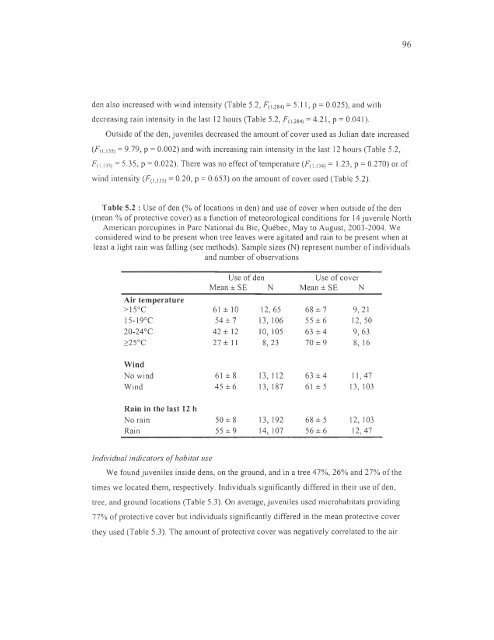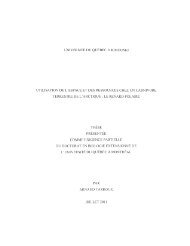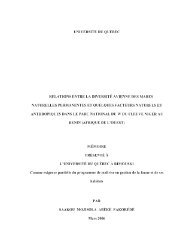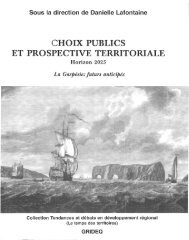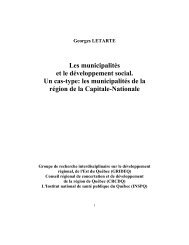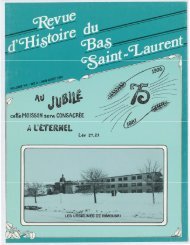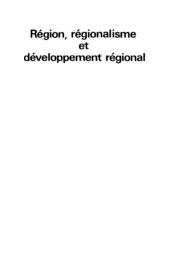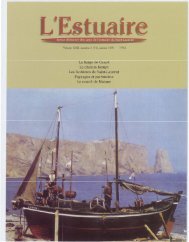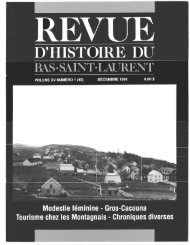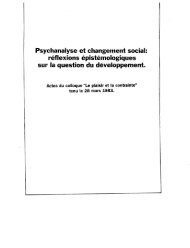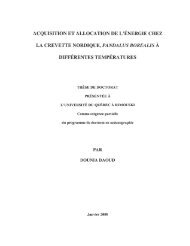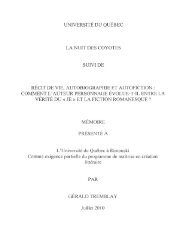influence du climat et de la prédation sur l'utilisation de l'habitat et la ...
influence du climat et de la prédation sur l'utilisation de l'habitat et la ...
influence du climat et de la prédation sur l'utilisation de l'habitat et la ...
You also want an ePaper? Increase the reach of your titles
YUMPU automatically turns print PDFs into web optimized ePapers that Google loves.
96<br />
<strong>de</strong>n also increased with wind intensity (Table 5.2, F (I ,284) = 5.11 , P = 0.025), and with<br />
<strong>de</strong>creasing rain intensity in the <strong>la</strong>st 12 hours (Table 5.2, F ( I,284) = 4.21, P = 0.041).<br />
Outsi<strong>de</strong> of the <strong>de</strong>n, juveniles <strong>de</strong>creased the amount of coyer used as Julian date increased<br />
(F(J ,135) = 9.79, P = 0.002) and with increasing rain intensity in the <strong>la</strong>st 12 hours (Table 5.2,<br />
F (J ,135 ) = 5.35, P = 0.022). There was no effect oftemperature (F(I , 134) = 1.23, P = 0.270) or of<br />
wind intensity (F(J ,135) = 0.20, P = 0.653) on the amount of co ver used (Table 5.2).<br />
Table 5.2 : Use of <strong>de</strong>n (% of locations in <strong>de</strong>n) and use of co ver wh en outsi<strong>de</strong> of the <strong>de</strong>n<br />
(mean % of protective coyer) as a function of m<strong>et</strong>eorological conditions for 14 juvenile North<br />
American porcupines in Parc National <strong>du</strong> Bic, Québec, May to August, 2003-2004. We<br />
consi<strong>de</strong>red wind to be present when tree leaves were agitated and rain to be present wh en at<br />
least a light rain was fa lling (see m<strong>et</strong>hods). Sample sizes (N) represent number of indivi<strong>du</strong>als<br />
and number of observations<br />
Use of <strong>de</strong>n<br />
Use ofcover<br />
Mean ± SE N Mean ± SE N<br />
Air temperature<br />
> 15°C 61 ± 10 12, 65 68 ± 7 9, 21<br />
15-19°C 54 ± 7 13 , 106 55 ± 6 12, 50<br />
20-24°C 42 ± 12 10, 105 63 ± 4 9, 63<br />
2:25 °C 27 ± Il 8, 23 70 ± 9 8, 16<br />
Wind<br />
No wind 61 ± 8 13, 112 63 ± 4 11 , 47<br />
Wind 45 ± 6 13, 187 61 ± 5 13 , 103<br />
Rain in the <strong>la</strong>st 12 h<br />
No rain 50 ± 8 13, 192 68 ± 5 12, 103<br />
Rain 55 ± 9 14, 107 56 ± 6 12, 47<br />
Indivi<strong>du</strong>a/ indicators of habitat use<br />
We foundjuveniles insi<strong>de</strong> <strong>de</strong>ns, on the ground, and in a tree 47%, 26% and 27% of the<br />
times we located them, respectively. lndivi<strong>du</strong>als significantly differed in their use of <strong>de</strong>n,<br />
tree, and ground locations (Table 5.3). On average, juveniles used microhabitats providing<br />
77% of protective coyer but indivi<strong>du</strong>als significantly differed in the me an protective coyer<br />
they used (Table 5.3). The amount of protective coyer was negatively corre<strong>la</strong>ted to the air


